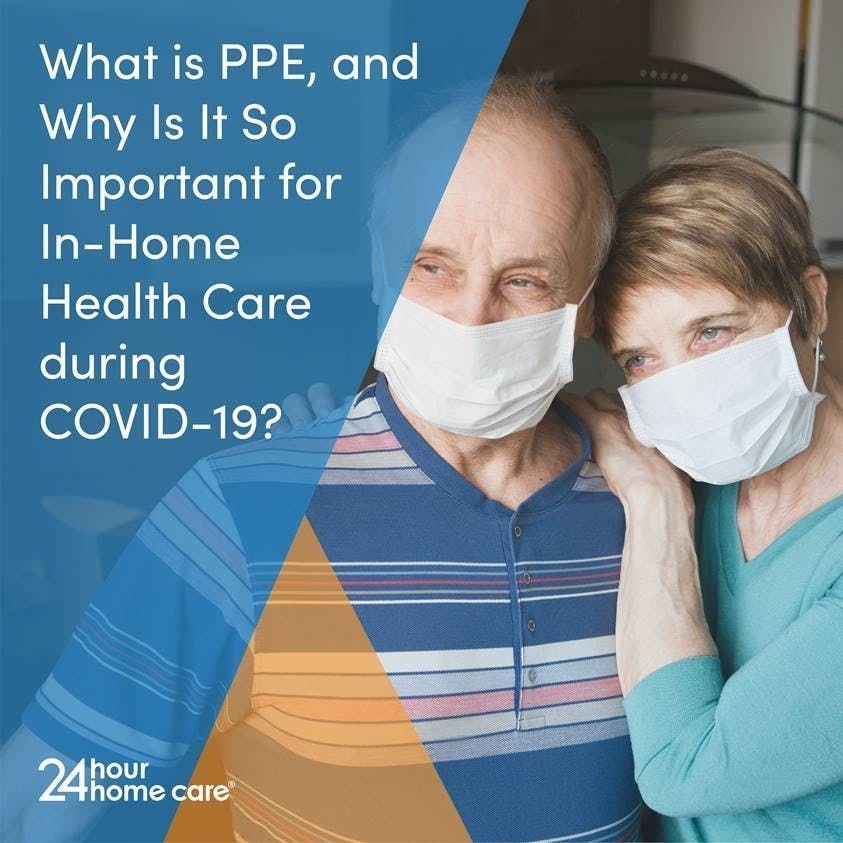Why is PPE Important for in-home health care during COVID

Personal protective equipment (PPE) is essential for caregivers, but what is PPE? Those who care for loved ones, as well as individuals who provide professional care services for others, must minimize their exposure to infectious illnesses. PPE provides that protection. In recent months, COVID-19 has opened our eyes to how easily infection spreads from one person to another before we realize the threat exists. We also know that the elderly and those who have compromised immune systems are more susceptible to infection. One way to protect ourselves and each other is to wear PPE.
Types of PPEs
According to the FDA, PPE helps block the transmission of contaminants from body fluids, respiratory secretions, or blood. It provides a non-disease specific barrier between infectious viral and bacterial contaminants and the skin, mouth, nose, or eyes. There are several different types of wearables that help prevent the spread of infection.
- Masks cover the mouth and nose; however, other types of masks also have a see-through plastic shield covering the eyes.
- Clothing, including gowns with long sleeves, aprons, head coverings, and shoe covers, prevent the transfer of contaminants between patients, the environment, and other individuals. Protective clothing reduces the spread of droplets or other body fluids to the caregiver’s skin and clothing.
- Gloves are worn to reduce the risk of contamination of the caretaker’s hands and to reduce the transmission of contaminants from the caretaker to those they are providing care for.
- Boots and closed-toe work shoes are recommended in areas where you may come into contact with harmful chemicals or are cleaning areas where infections have occurred.
- Respirator masks with eye protection are recommended for healthcare workers when performing aerosol-generating procedures such as tracheal intubations, tracheostomies, CPR, or bronchoscopies. These procedures have a very high risk of infection exposure to those performing and assisting with the procedures.
The Importance of Wearing Gloves for Caregivers
In addition to frequent handwashing, PPE provides additional protection from spreading an infectious condition. Wearing gloves is essential. Caregivers come into contact with saliva, blood, urine, stool, or other body fluids. Gloves are a crucial safeguard. Pathogens that cause disease can enter the body through the eyes, mouth, nose, or urogenital openings. They can also enter a person’s body through a wound or bite that has broken the skin. Caregivers wear gloves to not only protect themselves from infection but also to prevent spreading contaminants to others in the household or nearby surroundings. The Centers for Disease Control and Prevention also recommends wearing gloves when handling the laundry of those with an infection. Additionally, wearing gloves while disposing of trash that contains items used for the care of the individual is another key safeguard against cross-contamination.
Face Masks Offer Additional Protection
Another line of defense against the transmission of illness is a face mask. The Centers for Disease Control and Prevention recommends that cloth face masks be worn by infected individuals when they are around others in their homes or out of the house and at a doctor’s appointment, for example. Although the CDC does not consider cloth face masks to be PPE, they are appropriate for those who are not working in an infectious environment like a health facility. Those who have a medical condition that weakens their immune system should also wear face masks when leaving their home. For professional in-home caregivers and family members who serve as caregivers for a loved one, wearing a disposable face mask protects both the person they are caring for and themselves.
The Role of Shoe Covers
Healthcare workers wear shoe covers to prevent the spread of pathogens, although they are not currently a recommended PPE for healthcare workers caring for COVID-19 patients. They are beneficial for those seeking to maintain a cleaner environment and to keep shoes clean and free of contaminants or hazardous materials. Shoe covers are easy to put on and take off and are disposable.
Reusing PPE: Masks, Gloves, and Gowns
Some types of PPE can be washed and reused, but most are designed to be used one time by one person, then thrown away. Cloth face masks can be washed in a washing machine in hot water, then tumble dried. They can also be washed by hand. Lather with soap and scrub for at least 20 seconds with warm to hot water before tossing into the dryer. Respirator masks and protective eyewear can be reused, but proper decontamination should follow each use. Disposable gloves, masks, gowns, and aprons should also be thrown away after each use. However, many healthcare institutions are currently reusing paper and plastic gowns due to shortages to optimize the use of some PPE as per CDC recommendations. There is some disagreement within the professional medical community as to the safety of reusing these types of PPE.
Those who provide personal care services should be conscientious and vigilant when it comes to protecting the health and well-being of those they care for. Our caregivers follow the latest guidelines to ensure the safety and comfort of your loved one. Whether you are seeking around-the-clock care, respite care, companionship, meal preparation, or medication reminders, we’ll provide the hands-on assistance you need.
